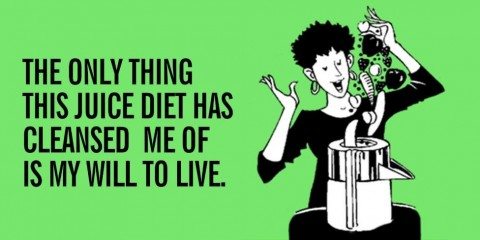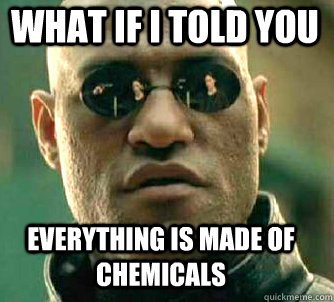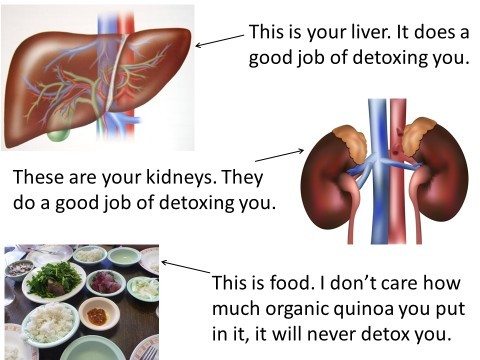
New Year, New You, right? Here’s a perennially popular post, revised for 2016.
With 2016 upon us, it’s finally time get serious about your health. You’re resolving to eat better and exercise more. But first, you need to reset your body – and purge yourself of all of your lifestyle and dietary overindulgences. But how? The options seem limitless, and everyone has advice: There’s Dr. Oz, Gwyneth, and even your favourite Kardashian has advice: They’re all telling you how it’s essential to “detox”, “cleanse” and “flush” away all of your toxins. Your local pharmacy has an ever-growing section of products promising a newer, more pure you: supplements, homeopathy, ear candles, and an entire aisle of “detox kits” all promise to suck toxins out of your body. Don’t forget your local naturopath who sells IV vitamin drips as the detoxification solution to your problems. The approaches may differ but all the advocates are completely convinced of one fact: Detoxing will deliver a renewed body and better health. Not only will you look better, you’ll feel better. It is a new year. Wouldn’t a purification from last year’s habits (dietary and otherwise) of last year be the best way to start? Well before you pull out your credit card, there is one fact that “detox” advocates are reluctant to tell you.
“Detox” is a scam
“Detox” is a legitimate medical term that has been co-opted to sell useless products and services. It is a fake treatment for a fake condition. Real detoxification isn’t ordered from a menu at a juice bar, or assembled from supplies in your pantry. Real detoxification is provided in hospitals under life-threatening circumstances — usually when there are dangerous levels of drugs, alcohol, or other poisons in the body. Drugs used for real detoxification are not ingredients in a smoothie. What’s being promoted today as “detox” is little different than eons-old religious rituals of cleansing and purification. Framing detoxification in religious terms won’t have the appeal in a world that values science. So use the word “toxin”, not sin, and call the ritual a “detox” – and suddenly you’ve given your treatment a veneer of what sounds scientific. Fake detox is marketed based on three easily-debunked ideas. Once you can spot the flaws, it’s easy to spot the spin and misinformation, and to make smarter, healthier decisions.
Premise one: Our bodies are accumulating toxins, so we need to detoxify
There’s a reason we fall for the marketing of detoxification — we seem hardwired to believe we need it, perhaps related to our susceptibility to ideas of sympathetic magic. Purification rituals date back to the earliest reaches of recorded history. The idea that we’re somehow poisoning ourselves and we need to atone for our sins seems to be a part of human nature, which may explain why it’s still a part of most of the world’s religions. It’s not miasmas or sin that we’re as worried about today, however. As our knowledge of biology grew, these fears manifested as “autointoxication.” Clean out the bowels, went the theory, and you could cure any illness. Science discarded autointoxication by the 1900’s as we gained a better understanding of anatomy, physiology, and the true cause of disease. Yet the term persists today – but now it’s marketing slogan. Today’s version of autointoxication argues that our environment is increasingly toxic, and it’s making us ill. Depending on who you ask, some combination of food additives, salt, meat, fluoride, prescription drugs, smog, vaccine ingredients, GMOs, not “eating clean”, or perhaps not “eating paleo” are causing a buildup of “toxins” in the body. And don’t forget gluten. Gluten is evil and therefore it is a toxin. (Never mind the science.) So what is the actual “toxin” that is causing you vague but apparently real harm? Detox kits and treatments never name the toxins that they remove, because they’ve never been shown to remove toxins. Picking one common drug store detox kit, Renew Life says:
Did you know that we come into contact with toxins every day—from the environment, our food, and even within our own digestive tract? While the body was built to process these toxins, today’s world places increased stress on our elimination channels. Renew Life Advanced Cleansing Programs are powerfully formulated to promote regular elimination and support the body’s natural detoxification process.* They provide targeted support to the body’s pathways of elimination: liver, lungs, lymphatic system, kidneys, skin, blood, and bowel.*
Note the vague language, which is universal with detox kits and treatments. Toxins are alluded to — but not named. It sounds somewhat plausible, but is non-specific.
The colon remains ground zero for detox advocates. Advertisements may argue that some sort of toxic sludge (sometimes called a mucoid plaque) is accumulating in the colon, making it a breeding ground for parasites, Candida (yeast) and other nastiness. Fortunately, science tells us otherwise: mucoid plaques and toxic sludge simply do not exist. It’s a made-up idea to sell detoxification treatments. Ask any gastroenterologist (who look inside colons for a living) if they’ve ever seen one. There isn’t a single case of mucoid plaque that’s been documented in the medical literature. Not one. The same can be said for rope worms. The do not exist.
Premise two: Illness is the result of chemical toxins
Marketing materials for detox treatments typically describe an array of symptoms and diseases linked to toxin buildup: A few that are general enough to apply to anyone (e.g., headache, fatigue, insomnia, hunger) with a few specifics to frighten you (cancer, etc.) Which toxins cause which disease is left out, and how the toxins cause the symptoms is never actually explained. Here again we see the contrast with real science. To establish that even a single chemical can cause disease requires a significant amount of research. Despite the variety of toxins that are claimed to be causing your illness, marketing claims for detox treatments always fail to link specific toxins to specific symptoms or illnesses. That’s because they can’t — there is no scientific evidence to show that detox treatments have any useful medical effects. 
The reality is that our bodies are constantly being exposed to a huge variety of natural and synthetic chemicals. Air is chemicals. Food is chemicals. Drugs are chemicals. Herbs are chemicals. The presence of any chemical in the body, (natural or synthetic) does not mean that it is doing harm. Many naturally-derived substances can be exceptionally toxic, and consequently the human body has evolved a remarkable system of defenses and mechanisms to defend against, and remove unwanted substances. The skin, kidneys, lymphatic system, gastrointestinal system, and most importantly, the liver make up our astoundingly complex and sophisticated intrinsic detoxification system.
Advocates for detox typically describe the liver and kidney as acting like filters, where toxins are physically captured and retained. It’s argued that these organs need to be cleaned out periodically, like you’d squeeze out a sponge, or change the air filter in your car. But the reality is that the kidney and liver don’t work this way. The liver performs a series of chemical reactions to convert toxic substances into ones that can be eliminated in bile or urine. The liver is self-cleansing — toxins don’t accumulate in it, and unless you have documented liver disease, it generally functions without any problem. The kidney excretes waste products into the urine — otherwise the substance stays in the blood. Anyone that suggests these organs need a “cleanse” is demonstrating that they don’t understand basic anatomy or physiology.
Premise three: Detox diets and treatments remove toxins
A recent review of detox diets in the Journal of Human Nutrition and Dietetics provides the best summary of the evidence supporting detox diets:
To the best of our knowledge, no rigorous clinical investigations of detox diets have been conducted. The handful of studies that have been published suffer from significant methodological limitations including small sample sizes, sampling bias, lack of control groups, reliance on self-report and qualitative rather than quantitative measurements.
The authors could find only a single detox product has been evaluated in the literature. Ultra Clear is a supplement that is claimed to detoxify the liver. The “evaluation” of Ultra Clear, was not blinded, and lacked any controls. The research subjects were 25 naturopathy students. Perhaps not surprisingly, the students reported improvements on a number of measures – but without a properly designed trial, the results don’t provide any evidence that the product is effective.
In general, there was no credible evidence to demonstrate that detox kits do anything at all. While they can be very unpleasant, they have not been shown to remove “toxins” or offer any health benefits. Coffee enemas are commonly promoted as toxin-removers. Coffee enemas offer no medical benefits. Vitamin injections are a popular naturopathic offering that has not been shown to provide meaningful benefits to consumers, as it has no beneficial effect on the ability of your liver or kidneys to work effectively. Chelation injections are touted as a cure-all for all kinds of illnesses, but unlike real chelation that is administered in hospitals for real cases of poisoning, naturopath chelation is not science-based and doesn’t seem to do much of anything (except enrich its proponents).
There is just as little evidence for detox programs. The only one to have been evaluated is via L. Ron Hubbard and the Church of Scientology, called the Hubbard Purification Rundown. It involves niacin supplements, saunas, exercise, polyunsaturated oil consumption, and vitamins, minerals and electrolytes. The protocol was used on a small group of firefighters after 9/11. With small sample sizes and no control groups, any critical evaluation of the results is impossible. Another evaluation with firefighters was equally limited by a lack of proper randomization and blinding. The same protocol was also used in healthy volunteers. Owing to a lack of blinding and placebo, the results are not credible, which is probably why the paper ended up published in Medical Hypotheses.
The bottom line? The onus is on promoters of detox to show their kits and protocols and methods actually deliver as promised — but they don’t, because they don’t have the evidence and they haven’t done the studies. If someone tells you that a detox kit or procedure is effective, ask for evidence.
Detox treatments can be harmful
If they provide no benefit, can detox treatments harm?
When it comes to simple dietary changes, there’s little evidence of harm. Eating more quinoa and kale, and less processed and refined foods is reasonable dietary advice for everyone. Homeopathic “detox” is also likely safe — with no active ingredients, homeopathy is an elaborate placebo system. As you get into more unorthodox detox treatments that actually contain active ingredients, there is the potential for harm. Coffee enemas are a detoxification process that has a real risk of harm. From a medical perspective, coffee enemas are considered unsafe. Rare but serious adverse events like septicemia (bacteria in the bloodstream), rectal perforation, and electrolyte abnormalities have been caused by coffee enemas. Deaths from the administration of coffee enemas have also been reported.
Vitamin injections won’t provide you with any medical benefits but don’t seem as risky, as long as you trust the sterile technique of your alternative provider. However, given some naturopaths seem to be willing to inject products intended for oral use, you might want to think carefully about taking a vitamin injection or chelation treatment, especially when there’s no evidence they do anything meaningful. Glutathione injections, while often touted as a “hangover cure” (among other uses) actually has very little published safety information available to support its use.
What about the detox kits found in pharmacies? Contents vary, but typically contain two categories of ingredients:
- A liver “booster” — typically milk thistle (Silybum marianum). If the liver can’t be wrung out and rejuvenated, can it be boosted to do a better job? Milk thistle is the most popular product purported to “boost” the liver’s effectiveness. Milk thistle has been studied in patients with alcoholic liver disease, and in patients with hepatitis B or C, and it has not been found to exhibit any meaningful effects. There is conflicting evidence on the use of silymarin, a milk thistle constituent, for acute toxic liver damage, but there is no published evidence to suggest that consuming milk thistle will cleanse you of unnamed, non-specific “toxins”.
- A laxative — Typically magnesium hydroxide, senna, rhubarb, cascara, etc. Laxatives are the ingredients in detox kits that give you the effect you can see (and feel). However, these ingredients can cause dehydration and electrolyte imbalances if not used carefully. Regular use of stimulant laxatives, like senna and cascara, are ill-advised for most healthy adults due to the risk of dependence and electrolyte depletion. They’re among the most potent laxatives, usually used for short periods to alleviate significant constipation or to clear out your bowels before a medical procedure. With regular use, your bowel can grow accustomed to the effects of laxatives which may result in constipation once you stop using them. It’s a perfect case of the treatment causing the illness: After the detox, you get could conceivably become constipated – just in time for another “detox”.
Side effects can continue once a detox ends. Some people experience post-detox effects like nausea and diarrhea. Advocate call these “cleansing reactions” and will assure you it’s “toxins leaving the body”. A more plausible, science-based explanation is that this is a consequence of restarting the digestive process after a period of catharsis, where, depending on the extent and duration of fasting, little to no digestion occurred, and the normal gastrointestinal colonies of bacteria may have been severely disrupted. It’s the same effect seen in hospitalized patients who have difficulty initially digesting food after being fed intravenously. The detox ingredients, and resulting catharsis, may irritate the colon to such an extent that it may take time for digestion to return to normal.
Immediate weight loss is not uncommon after a detox, especially one that involves a laxative. Unfortunately this is usually due to losses in water and possibly muscle tissue, depending on the how disruptive the detox was to normal body function. Regardless of the weight loss, the body will move back to its pre-detox weight over time if diet and activity levels remain the same.

Image via @statsguyuk
There are no quick fixes
Any product or service advertised with the words “detox” or “cleanse” in the name is only truly effective at cleansing your wallet – of cash. Alternative medicine’s ideas of detoxification and cleansing have no basis in reality. There’s no published evidence to suggest that detox treatments, kits or rituals have any effect on our body’s ability to eliminate waste products effectively. They do have the ability to harm however — not only direct effects, like coffee enemas and purgatives, but they also distract and confuse people about how the body actually works and what we need to do to keep it healthy. “Detox” focuses attention on irrelevant issues, giving the impression that you can undo lifestyle decisions with quick fixes. Improved health isn’t found in a box of herbs, a bottle of homeopathy, or a bag of coffee flushed into your rectum. The lifestyle implications of a poor diet, lack of exercise, smoking, lack of sleep, and alcohol or drug use cannot simply be flushed or purged away. Our kidneys and liver don’t need a detox treatment. If anyone suggests a detox or cleanse to you, remember that you’re hearing a marketing pitch for an imaginary condition.
